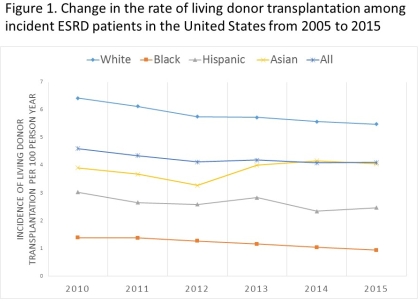Racial/Ethnic Disparities in Living Donor Kidney Transplantation before and after the New National Kidney Allocation System
1Department of Surgery, Emory University School of Medicine, Atlanta
2Department of Health Policy & Management, Emory University, Atlanta
3Department of Medicine, Emory University School of Medicine, Atlanta
4School of Medicine, Columbia University, New York
5Department of Epidemiology, Columbia University, New York
6Department of Epidemiology, Emory University, Atlanta
7Emory Transplant Center, Emory Healthcare, Atlanta.
Meeting: 2018 American Transplant Congress
Abstract number: C123
Keywords: Allocation, Kidney transplantation
Session Information
Session Name: Poster Session C: Kidney Living Donor Issues
Session Type: Poster Session
Date: Monday, June 4, 2018
Session Time: 6:00pm-7:00pm
 Presentation Time: 6:00pm-7:00pm
Presentation Time: 6:00pm-7:00pm
Location: Hall 4EF
We aimed to assess the potential unintended impact of a new national kidney allocation system (KAS) in December 2014 on living donor kidney transplant (LDKT) among U.S. end-stage renal disease (ESRD) patients and to evaluate racial/ethnic disparities in LDKT under KAS. We examined LDKT pre- and post-KAS among incident (N=709,902) and prevalent (N= 1,127,612) dialysis patients from the U.S Renal Data System database (2010-2015) using multivariable time-dependent competing risk Cox models and interrupted time-series models. Among incident dialysis patients, the annual incidence rate of LDKT steadily declined from 4.6 in 2010 to 4.1 per 100 person-years in 2015. In adjusted analyses, the rate among incident patients was 12% lower post- vs. pre-KAS (HR: 0.88; 95% CI: 0.85-0.91). Pre-KAS, blacks had a 65% lower LDKT rate vs. whites (HR: 0.35; 95% CI 0.33-0.36); following KAS, disparity was not significantly changed (HR: 0.34; 95% CI: 0.31-0.38). The monthly rate of LDKT among prevalent ESRD patients was 8.7/10,000 (13.1/10,000 for whites, 3.4/10,000 for blacks, 7.2/10,000 for Hispanics, and 8.1/10,000 for Asians) in the pre-KAS era. Post-KAS, rates were lower (7.6/10,000 overall; 11.7/10,000 for whites, 2.5/10,000 for blacks, 5.9/10,000 for Hispanics, and 7.9/10,000 for Asians). However, in adjusted time-series analyses, the LDKT rate was not significantly changed post- vs. pre-KAS (p=0.32). LDKT rates was not significantly impacted among both incident and prevalent patients after the change of kidney allocation policy. The black vs. white disparity in LDKT rate was similar in the pre- and post-KAS periods.
In adjusted analyses, the rate among incident patients was 12% lower post- vs. pre-KAS (HR: 0.88; 95% CI: 0.85-0.91). Pre-KAS, blacks had a 65% lower LDKT rate vs. whites (HR: 0.35; 95% CI 0.33-0.36); following KAS, disparity was not significantly changed (HR: 0.34; 95% CI: 0.31-0.38). The monthly rate of LDKT among prevalent ESRD patients was 8.7/10,000 (13.1/10,000 for whites, 3.4/10,000 for blacks, 7.2/10,000 for Hispanics, and 8.1/10,000 for Asians) in the pre-KAS era. Post-KAS, rates were lower (7.6/10,000 overall; 11.7/10,000 for whites, 2.5/10,000 for blacks, 5.9/10,000 for Hispanics, and 7.9/10,000 for Asians). However, in adjusted time-series analyses, the LDKT rate was not significantly changed post- vs. pre-KAS (p=0.32). LDKT rates was not significantly impacted among both incident and prevalent patients after the change of kidney allocation policy. The black vs. white disparity in LDKT rate was similar in the pre- and post-KAS periods.
CITATION INFORMATION: Zhang X., Melanson T., Plantinga L., Basu M., Pastan S., Mohan S., Garber M., Patzer R. Racial/Ethnic Disparities in Living Donor Kidney Transplantation before and after the New National Kidney Allocation System Am J Transplant. 2017;17 (suppl 3).
To cite this abstract in AMA style:
Zhang X, Melanson T, Plantinga L, Basu M, Pastan S, Mohan S, Garber M, Patzer R. Racial/Ethnic Disparities in Living Donor Kidney Transplantation before and after the New National Kidney Allocation System [abstract]. https://atcmeetingabstracts.com/abstract/racial-ethnic-disparities-in-living-donor-kidney-transplantation-before-and-after-the-new-national-kidney-allocation-system/. Accessed December 20, 2025.« Back to 2018 American Transplant Congress
